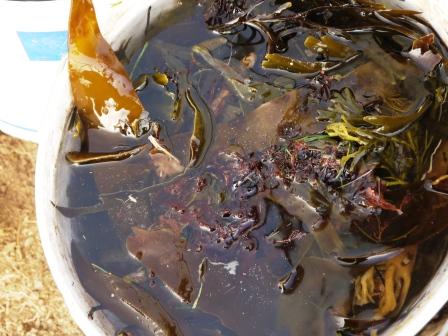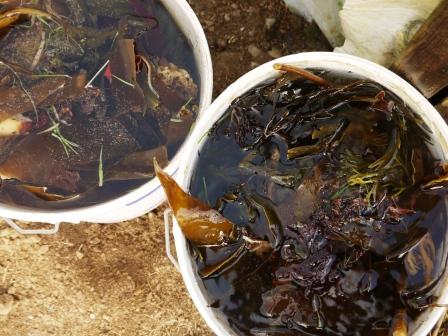This is the perfect time of year to get some fertilising teas made for your veggie garden. You can of course buy a seaweed fertiliser, but if you’re planning a trip to the coast anytime soon, why not bring a bucket or two of it home to make your own Organic Seaweed Plant Feed ?

We only live a mile from the beach, and with the strong winds we’ve had of late, I knew there would be lots of fresh kelp washed up from the depths.
First collect your seaweed. You want the fresh stuff, that’s ideally been washed up on the shore line. If you have to cut seaweed from rocks (not ideal) please make sure you leave at least a 3 inch stump for the plant to grow back.
If you pick up the stuff that’s already starting rotting on the beach, your veggie plants will be missing out on an extra little bit of nutrients. However, half rotted seaweed tea is far better than no seaweed tea!

Hot to Make Seaweed Plant Food
When you get it home, tip it out onto the grass and using a hose or watering can, rinse the sand and salt off the weed. You’ll probably never get it all off, but do as best you can.
Pop it all back into another bucket or two, fill to the top with water and leave to soak. If they are going outside, you’ll need a lid of sorts to stop rainwater diluting your tea. Mine are currently resting in the poly tunnel, although they will soon become too smelly to have in such an enclosed space – you have been warned!
Give it a good stir with a big stick every now and then. You can start using it within a couple of weeks, although the beauty of starting it so early in the season is that it becomes more potent after leaving it for a good couple of months.
It will be too strong to use neat, so make sure you dilute it 10:1 (10 parts water to 1 part tea) in a watering can before feeding plants.
When you have used all of the tea from a bucket, you can sue the same seaweed for a second batch of tea. However, as the nutrients won’t be so dense second time around, I’d be inclined to use it as a great excuse to chuck it on the compost heap & head back down to the beach for some more :)
Helene Dsouza I Masala Herb says
Oh I never knew I could do that with seaweeds. My garden surely needs some nutritious but I ll have to go in the rainy season to collect seaweed. Thanks for the great tips jane!
Jane Sarchet says
I love the idea of you making this tea in India Helene, I bet it doesn’t take so long to rot down either. Do let me know how you get on x
Tammy/Our Neck of the Woods says
What a great tip! I wish I lived closer to a beach :) I’ve heard of different types of “compost tea” but never tried them out. Seems like they would be wonderful for the garden!
Jane Sarchet says
Absolutely, horse or rabbit dung are supposed to be fantastic too (wouldn’t it forever to collect enough rabbit dung though?!)
leslie says
I used to have 2 bunnies, Snicker and Doodle, that I got specifically for the poo benefits. I heard somewhere that 1 average size bunny could fertilize a city block! And it goes straight on the beds (not so with poo of other animals [horse/cow/chicken], which needs to be composted because it is too “hot” – goat may be good straight, maybe). Now I get donated bunny poo from a gal who does local bunny fostering. She has 5, and I get a 5-gallon bucket every month.
Jane Sarchet says
Hi Leslie! Funny, I recently got a pair of bunnies to breed from and I hadn’t heard about the benefits of their poop – thank you!
Janie x
Ethel Fernandez says
This looks very weird but I am interested in knowing what it can do to the body. It surely has many benefits considering the efforts to extract it. I wonder how it tastes.
Jane Sarchet says
Hi Ethel, I guess there would no reason not to drink it, but this stuff is for my veggies plants!
Janie x
leslie says
You can purchase kelp/seaweed at Asian food markets, and add it to soups/stews or steep it like tea for a broth-like beverage. It is super rich in minerals and iodine. Depending on the harvest site, I don’t know of a reason not to do this from self-harvested source. We could probably dry kelp/seaweed in the sun on a screen, and then use it to make tea. I would soak it in some water before lying it out to dry, just to try to get any possible toxins/pollutants off/out of it that might have gathered on its way to shallow/shore area, but I don’t know much about it, or how it is actually harvested for markets. I just know I always add a strip of it to my bean soups (purportedly cuts down on the gas effect).
dolores baswick says
great info! can you put the finished tea in a closed bottle to store for future use? do you have to boil it to bottle it? thanks!!
Jane Sarchet says
Hey Dolores, I make the tea as a plant food so I leave it in the buckets until I need to use it.
Janie x
Daiva says
How bad is the smell? If bucket is left open (like with cheesecloth) and mixed every few days, wouldn’t it get enough aerobic bacteria and smell okay? Some people add molasses to encourage good bacteria growth.
Dirt farmer says
Also great as a foliar spray. I useit as a top mulch for slug repellent. Great just added to the soil and compost. I use the seaweed tea in AACT teas and also using a microbial inoculate can speed breakdown process. I’ve heard of brewing up to a year and also using a pump and air stone would encourage better microbial growth. Amazing stuff
Jane Sarchet says
That’s really interesting DF, thank you so much for taking the time to share :)
Jane x
Pattie cakes says
Wow slug repellent and mulch??!!!! Forever grateful for this information. I dont like using sprays for my vegetables, so sea weed here I come…..